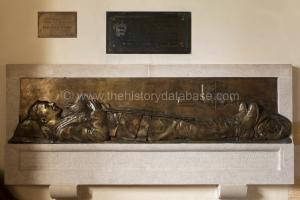Text this colour links to Pages. Text this colour links to Family Trees. Place the mouse over images to see a larger image. Click on paintings to see the painter's Biography Page. Mouse over links for a preview. Move the mouse off the painting or link to close the popup.
St Barnabas Church, Stock Gaylard is in Stock Gaylard, Dorset, Churches in Dorset.
Before 1400. St Barnabas Church, Stock Gaylard [Map]. Effigy of Ingelramus de Waleys. Early Medieval Period. When the tomb was opened a chamber measuring 4' x 1'6 by 1' was found beneath the effigy. The chamber contained a dismembered skeleton and fragments of red leather believed to be the bag in which Ingelramus' bones were brought back from the Holy Land for burial. Right Leg over Left.





After 1917. St Barnabas Church, Stock Gaylard [Map]. Memorial to Captain Harry Farr Yeatman. Son of Harry Yeatman RN 1839-1884 whose memorial is above. Captain in the Dorsetshire Yeomanry. Killed 21st November 1917 in sight of Jerusalem. Buried Jerusalem.
Yeatman's Regiment, like the rest of the 6th Mounted Brigade, withdrew to Beit Ur al Fauqa where it received orders to advance towards Beitunia (Beituniye), nine miles north of Jerusalem and a few miles south-west of Bireh, on 21 November 1917. At about 11.30 hours the 6th Mounted Brigade, led by Yeatman's 1/1st Dorset Yeomanry, began to descend from the hills but found themselves held up once again by the western slopes of the Zeitun Ridge. The fighting here went on until late in the winter afternoon and involved several failed attempts to take the ridge. But at about 16.40 hours, Turkish reinforcements arrived and immediately counter-attacked, forcing the exhausted men of the Mounted Yeomanry Brigade, who had been holding an advanced position all day, to retire. During their withdrawal, Yeatman's Regiment lost seven officers and 44 ORs killed, wounded or missing and although its War Diary does not mention Yeatman by name, later reports confirm that when one of his men was wounded during the withdrawal, Yeatman went out to bring him in under heavy fire and was killed in action, aged 37. He is buried in Jerusalem War Cemetery, Grave E.56. His obituary in The Times says that at the time of his death, he was to be recommended for the MC. He left £3,762 13s 2d. The Zeitun Ridge was the scene of more fierce fighting and would not be taken until 27 December 1917.